Trane® HVAC age
How to determine the date of production/manufacture or age of Trane® brand HVAC Systems.
The industry average service design life for most forced air furnaces is 15-20 years, and the industry average service design life for most air conditioning condensing units is 10-15 years. The average service design life of boilers can vary from as little as 10 years to as many as 50 years depending on the type and quality of materials used in their manufacture. Routine upkeep/maintenance, regional weather/climate, and location/placement of the mechanical systems will all play critical roles in the longevity of these systems.
See also: Estimated Useful Service Life Expectancies
Parent Company: Ingersoll Rand
Subsidiaries or other related brands: Trane® | Ingersoll Rand® | American Standard® | General Electric (GE)® | Ameristar® | Oxbox® |
Trane® has utilized multiple serial number formats over the years as a result of multiple mergers and acqusitions. Trane is an old and very established company with its roots originating in 1885 as a family plumbing business in La Crosse, Wisconsin which developed an innovative low-pressure steam heating system. By 1913 the family business had incorporated as The Trane Company, and began establishing themselves as a well-known climate control pioneer over the next hundred years.
Ingersoll Rand® acquired Trane in June of 2008. (History information from Trane®)
The serial number styles used during these many company changes are reflected below. Several styles overlap in certain years as the newly acquired companies transitioned. Several were only used for a brief period, some were used intermittently at various periods and for various products, while others continued to be used for many years under the trademarked Ingersoll Rand®, American Standard®, Trane®, and even GE® brand names. Our research also indicates that some styles used only a sequential order numbering that has no obvious method of decoding.
Because of the wide variety of styles or formats that Trane® used and the often similar styles found, other determining clues such as condition of the unit, style of the data plate, ANSI or CGA standards compliance dates, dates on service tags, and simple common sense should be used to approximate or estimate the year or decade of manufacture.
Example serial number styles/formats found:
- Style 1: 91531S41F -or- 10161KEDAA -or- 130313596L
- Style 2: R1742DWBF -or- M35123456
- Style 3: A92M07217
- Style 4: 123456T -or- B123456
- Style 5: 2D-1234
- Style 6: H011870M03
- Style 7: F91-90391
- Style 8: EKK1915 (European style)
Legend: Year is RED; Month is GREEN; Week is BLUE
Style 1: 91531S41F or 10161KEDAA or 130313596L
This Trane (American Standard) style began use in 2002. It consists of at least 3 or 4 digits at the beginning of the serial number.
From 2002 to 2009:
Year of manufacture can be determined by using the 1st position (digit) of the serial number. The 2nd & 3rd positions (digits) of the serial number represent week.
Starting in 2010:
Year of manufacture can be determined by using the 1st & 2nd positions (digits) of the serial number. The 3rd & 4th
positions (digits) of the serial number represent week.
The remaining characters (sequence) can be any combination of letters or numbers usually starting with a single digit representing day of the fiscal week.
This style is VERY common and is still found in use under the Trane, American Standard, Ameristar, and Ingersoll Rand brand names to name a few. Please see the examples below.
The MFR Date is commonly included on the data rating plate along with the serial number.
Our research indicates that some earlier commercial and residential Trane models manufactured circa 1978-79 may have also used this style. Should you encounter one of these, their estimated age should be clearly evident based on condition or appearance alone, and they will have far exceeded the average estimated end of useful service life (EUL).
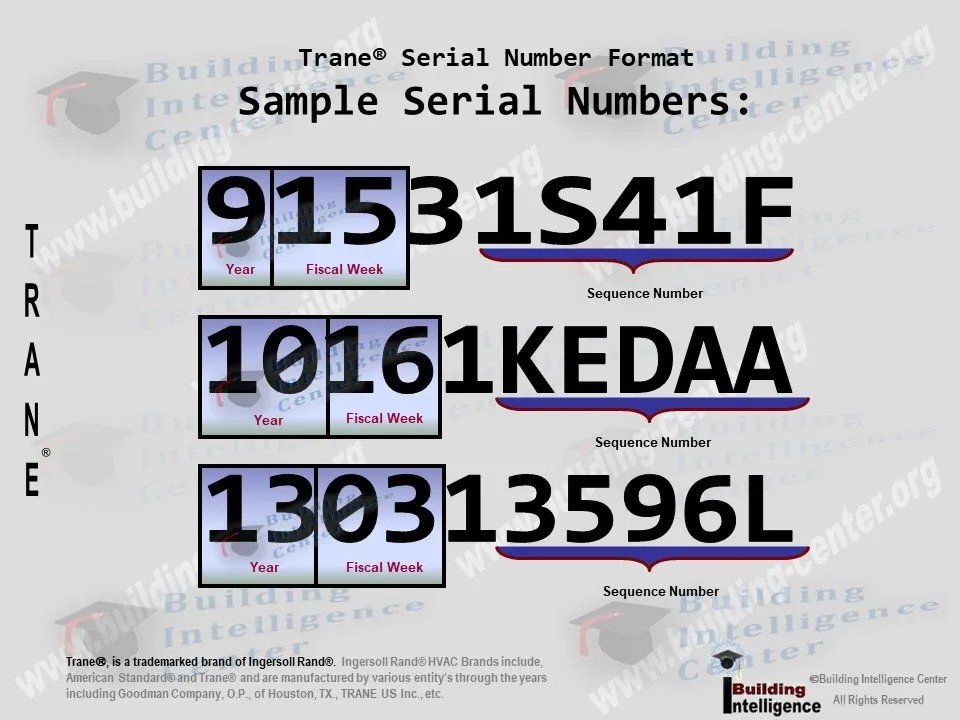
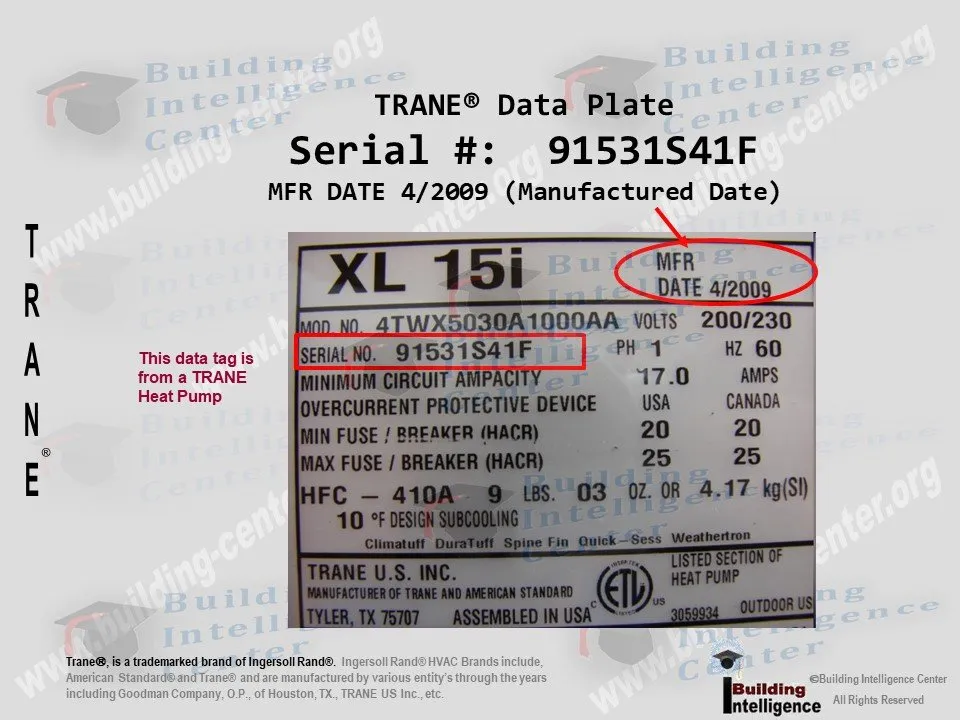
Style 2: R1742DWBF -or- M35123456
This Trane style used from 1983 through 2001. This style typically consists of 9 characters, always beginning with a letter followed by 2 digits.
Year of manufacture can be determined by using the 1st position (letter) of the serial number (see chart). The 2nd & 3rd positions (digits) of the serial number represent week.
The remaining characters (sequence) can be any combination of letters or numbers usually starting with a single digit representing day of the fiscal week.
The company ceased using letters to designate year of manufacture after 2001 (represented by the letter "Z"), so any system encountered that uses this styling will typically be very near or has exceeded the average estimated useful service life (EUL). Beginning in 2002, numbers rather than letters are used for the year designation which is depicted in style 1 above.
The MFR Date is sometimes included on the data rating plate along with the serial number, especially in later years toward the end of this style use.
Additional Examples: F23456789 would be manufactured the 23rd week of 1991. C01D47415 would be manufactured the 1st week of 1988.
Note: The letters "S" and "Z" are easily confused because they are not listed in logical order in the chart below. "S" represents 1986, and "Z" represents 2001. The letters "A", "I", "L", "O", & "Q" were not used with this style.
CAUTION: This style can be easily confused with styles 3, 4, 6, & 7.
See also style 4 for additional relevant information.
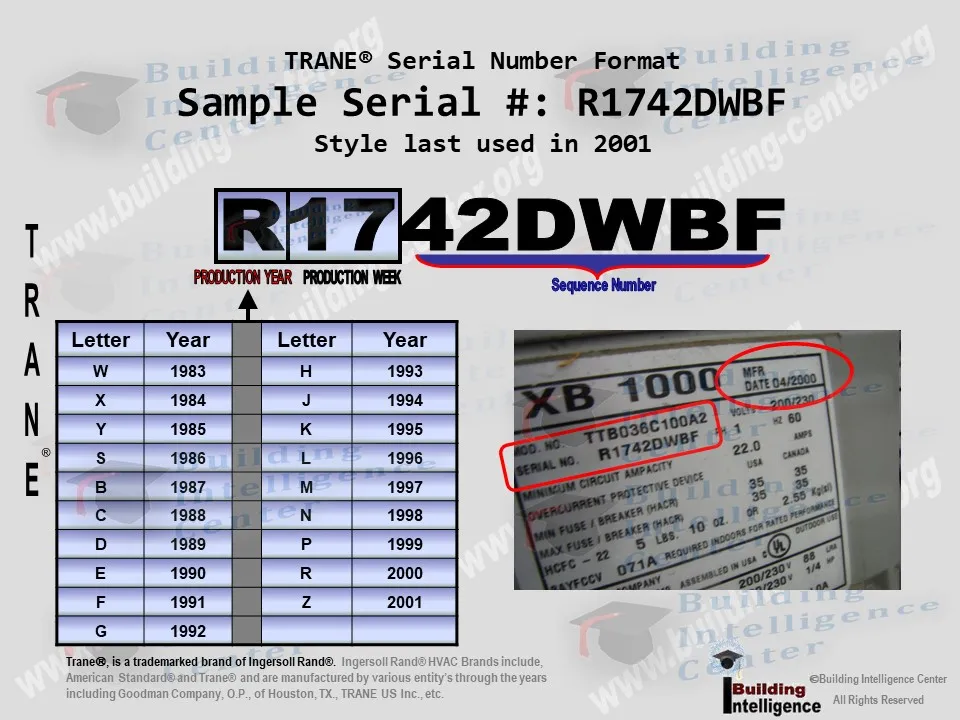
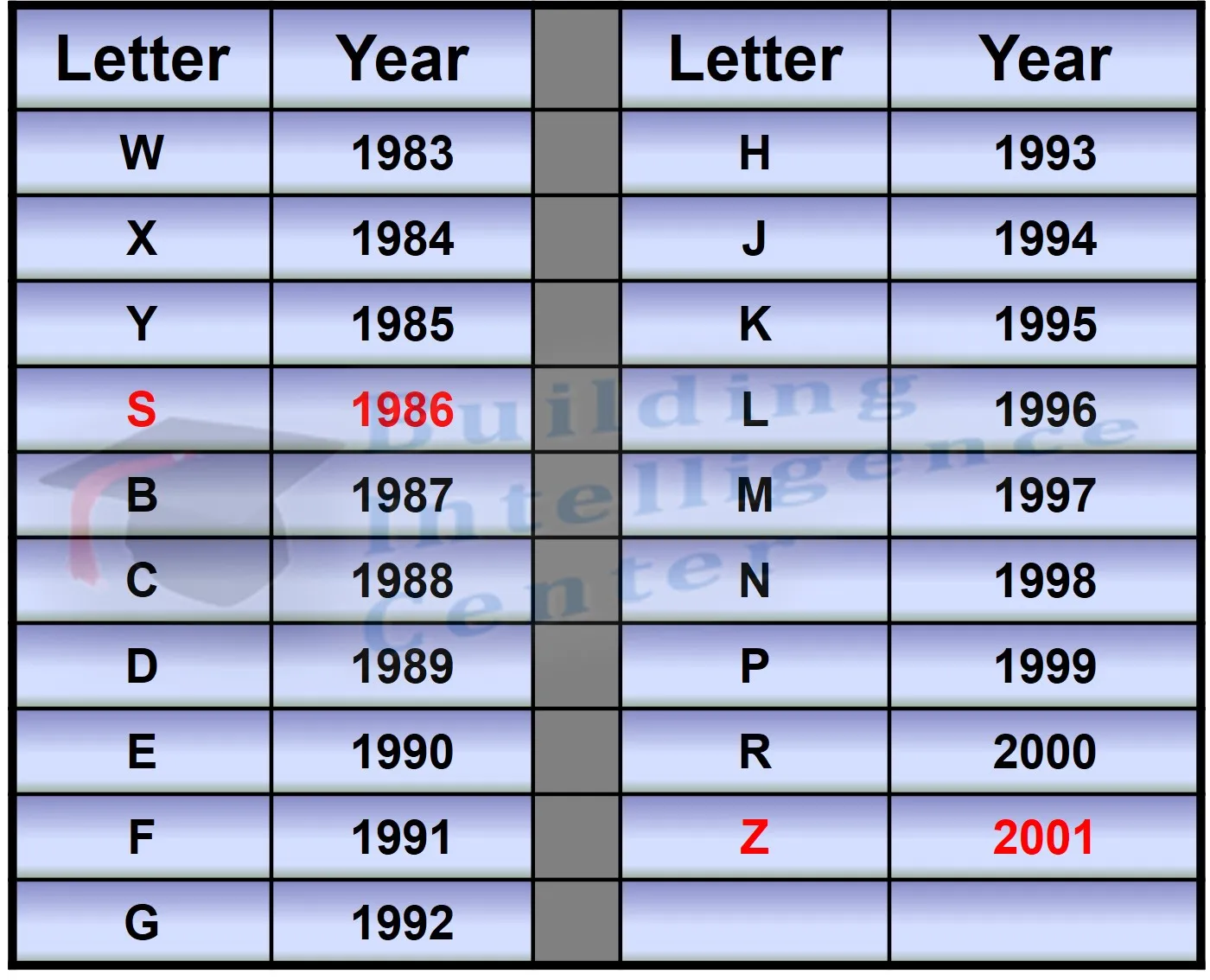
Style 3: A92M07217
Year of manufacture can be determined by using the 2nd & 3rd positions of the serial number
Month of manufacture can be determined by using the 4th position of the serial number (months 1 through 12)
This Trane style began seeing use in the 1970's and has reappeared in various models, brands, and products over the years.
**NOTE** This format is very similar to style 2 above as it is also 9 characters in length, and can be easily confused. The difference is this style begins with a letter, followed by a 2 digit year, and then another letter. Also helpful is to note the ANSI standard revision year. (See photo)
The first letter represents the factory code. Two factory codes we have encountered include "A" and "C"
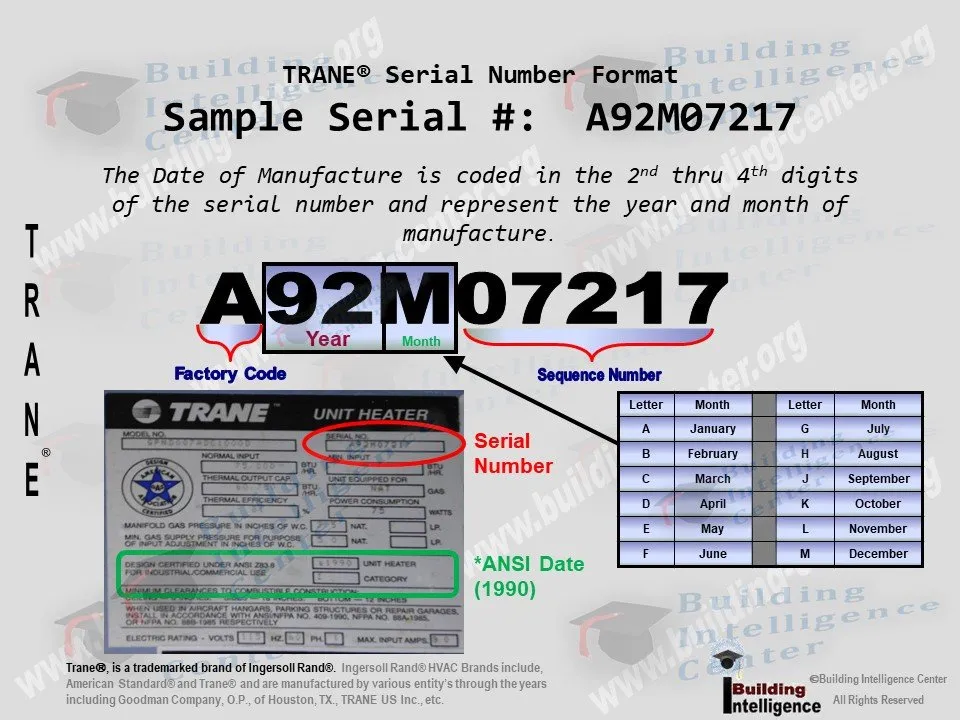
Style 4: 123456T -or- B123456
Style used exclusively from 1981 - 1983
Depending on the product type Year of manufacture can be determined by the letter in either the first or last positions of the serial number
See the small chart below.
Note: This style appears to be the early beginnings of style 2 format above. The letters A, B, & C and O, T, & U represent 1980, 1981, & 1982 respectively for some Trane products or models manufactured during this era. This explains to some extent the gaps found in the letter coding of the chart for style 2. Regardless, the condition, appearance, and/or type of unit using this style should be clearly evident of the era of manufacture.
It is possible that letters L, M, & N may also be used; however, we generally have only found their use in style 6 listed below.
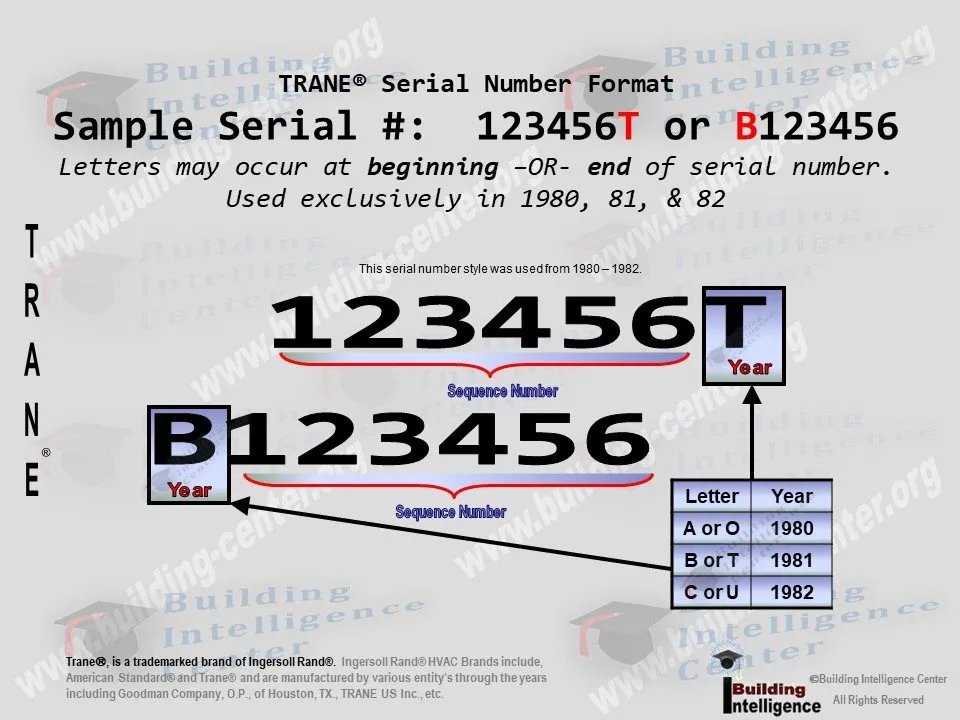
Style 5: 2D-1234
This Trane style began appearing in the 1970's; however, some research indicates it was also used during the early 1980's for some limited products or models.
The Year of manufacture is coded in the first digit of the serial number.
The Month of manufacture is coded in the second letter of the serial number.
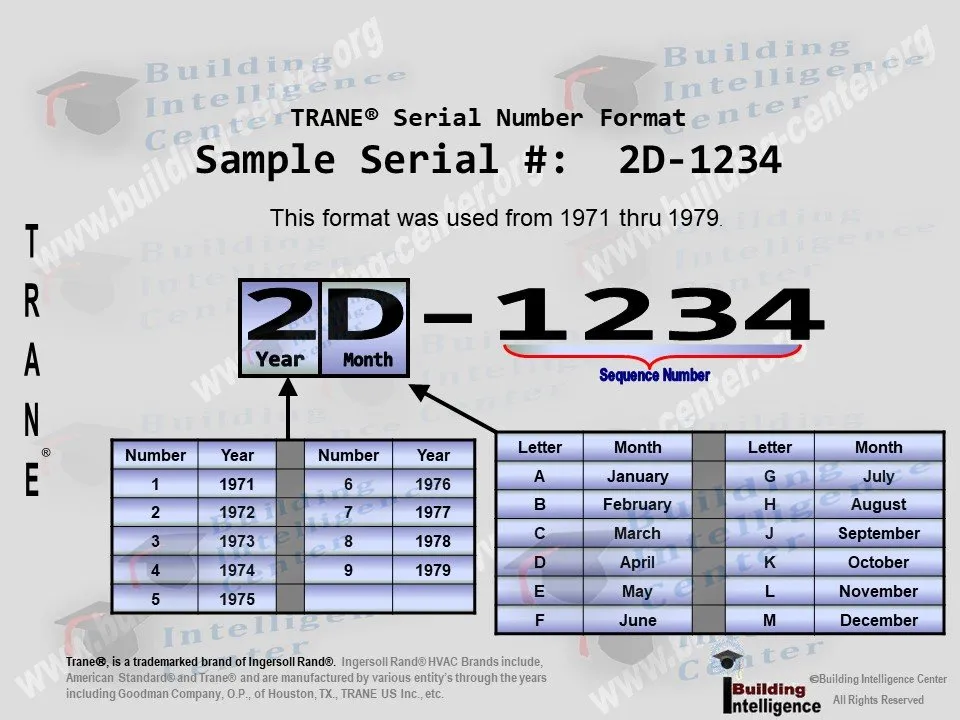
Style 6: H011870M03
This format was found on some Trane systems manufactured from 1980 - 1982.
The year of manufacturer is coded in the third to last character (letter).
The next two (last) digits represent week of manufacture.
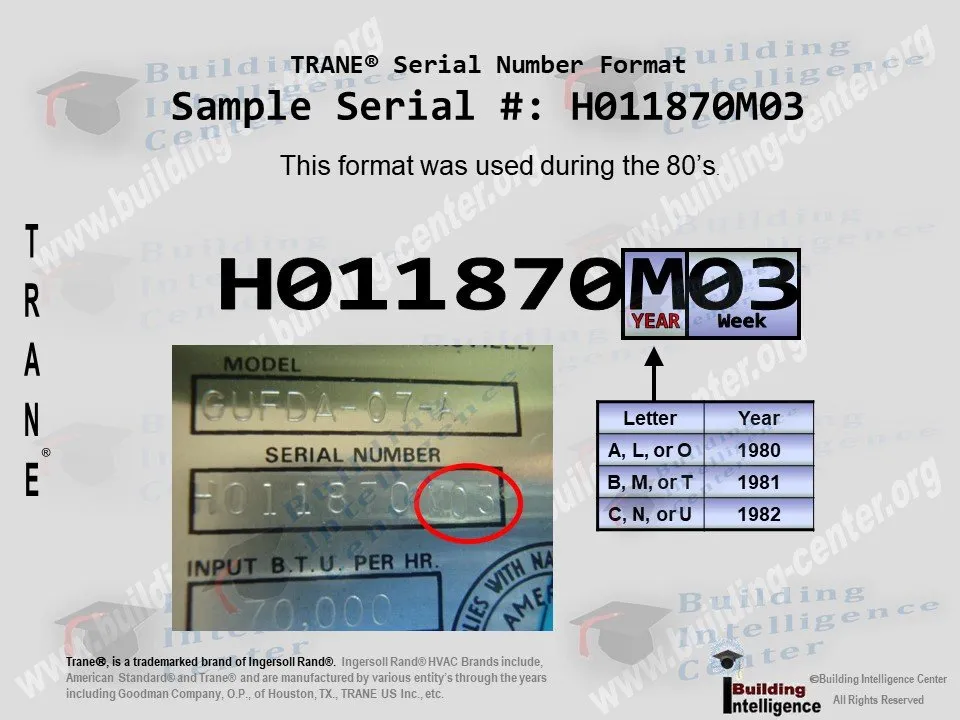
Style 7: F91-90391
This Trane style is very similar to style 3 above, and also began seeing use in the 1970's. It has reappeared in various models, brands, and products over the years.
CAUTION: Not to be confused with the 9-character style 2 or style 3. This format is only 8 characters (excluding hyphen), and used a hyphen after the first three characters (date codes) in the serial number.
This style was generally used from the 70's into the 90's.
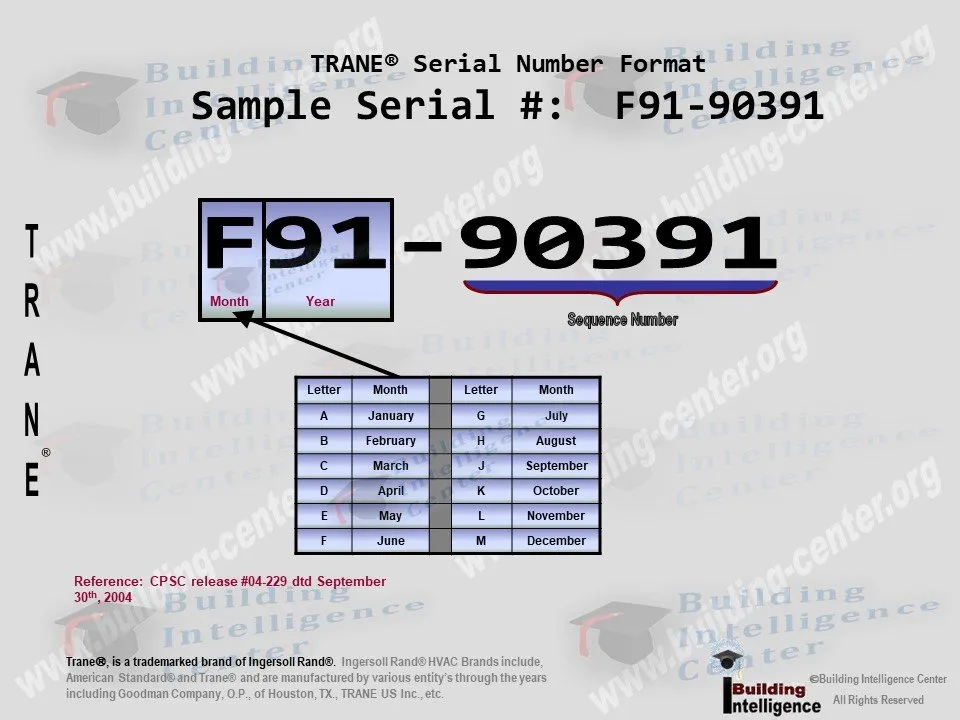
Style 8: EKK1915 (European style)
This style appears to be a European product style serial number. The unit was manufactured by Trane (American Standard) in Golbey, France. This facility manufactures commercial and industrial chillers.
The data plate shown below includes the manufacture date (month and year) clearly noted.
We can only presume the letters at the beginning of the serial number denote the year and month of manufacture; however, the style does not match any known reference charts for their letter coding during these years.
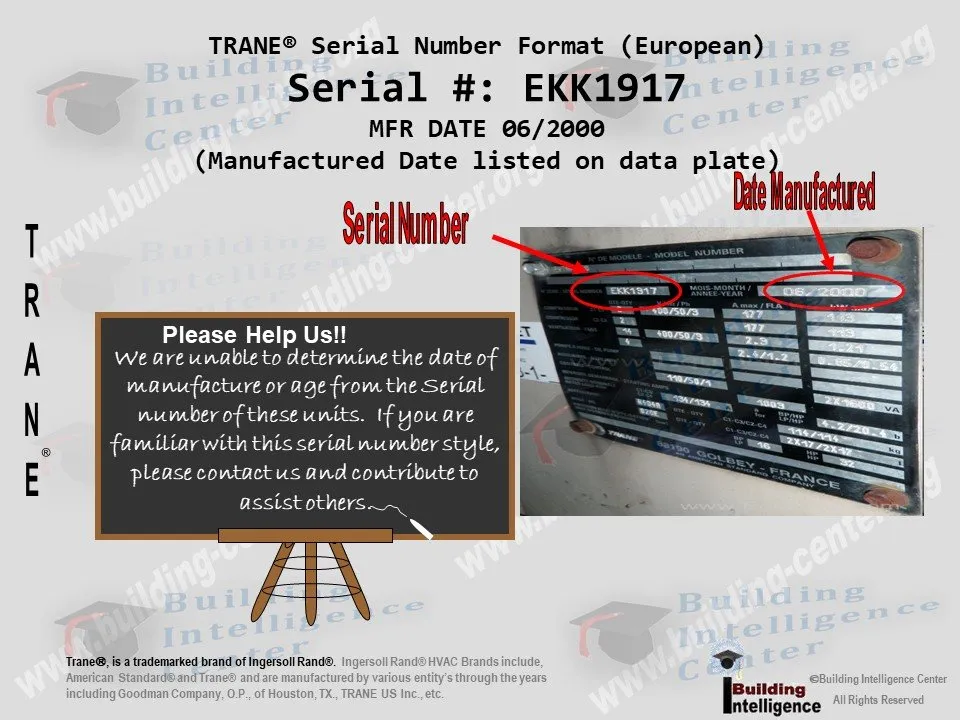
Trane® History¹
-
Trane is an old and very established company with its roots originating in 1885 as a family plumbing business in La Crosse, Wisconsin which developed an innovative low-pressure steam heating system. By 1913 the family business had incorporated as The Trane Company, and began establishing themselves as a well-known climate control pioneer over the next hundred years.
Trane acquired Sentinel Electronics during the late 1970's, and later General Electric's Central Air Conditioning Division in 1982. In 1984, American Standard Companies, Inc.® acquired the Trane Company and launched its American Standard Heating & Air Conditioning® brand four years later. In 2007, American Standard Companies divided, and Ingersoll Rand® later acquired Trane in June of 2008.
¹Excerpts from (Trane®)
